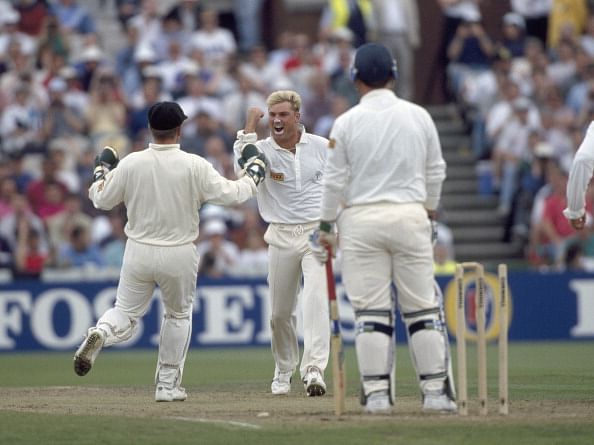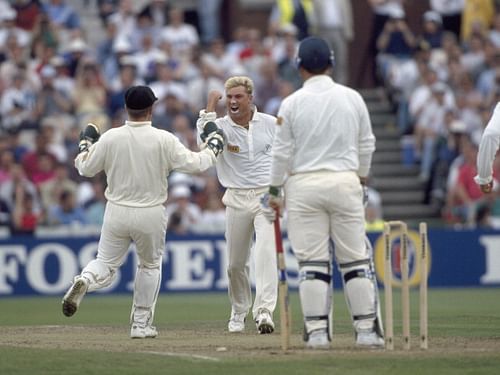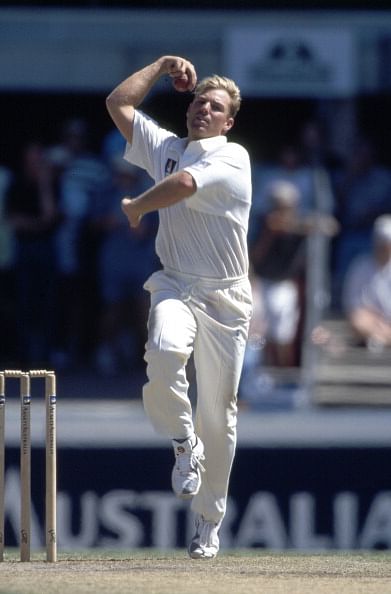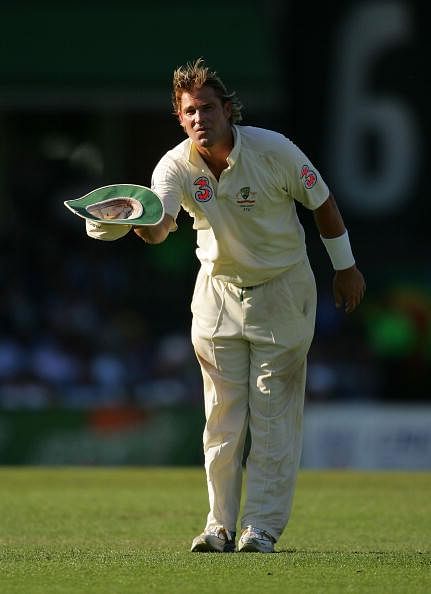
The Ashes Legends: Of spins and turns - Shane Warne

Shane Warne after delivering the ‘Ball of the century’
The British rains, they say are such party spoilers. It rained just before the first Test match of Ashes series of 1993 in Old Trafford, leaving the pitch damp and wet. The cricket pundits were of the view that any kind of leg spin would be pretty much useless in these conditions. Australia came down to bowl with 3 fast bowlers and the lone spinner – Shane Warne.
One wicket down, Mike Gatting comes in to bat. Aussie captain Allan Border brings up their spinner. His first ball in an Ashes series – first in a Test against England – Shane Warne takes a slow run-up and delivers a leg break. The right-handed batsman Gatting was a pro in playing spin bowling. He assessed the situation and jut his left leg forward, bringing his bat into position to play away the ball, with no question of an LBW.
What happened next was unbelievably astonishing and jaw dropping. As the ball looped down, the batsman and everyone alike were deceived by its path of flight and assumed it shall land on the leg side. But it bounced, and spun with such ferocity that it passed the outside edge of Gatting’s bat, hit the off-stump and dislodged the bails. A bewildered Gatting could not have seen that coming. The Aussies celebrated! The party, much despite the English rains efforts, had just started.
I just described what was rightfully termed “the ball of the century” or the “Gatting ball”, or simply “that ball”. From thereon, Shane Warne went on to take 3 more wickets in that particular innings and 4 in the next, winning the Man of the Match award. Australia won the Ashes series by 4-1. Warne ended up winning the Man of the Series award after picking 34 wickets at an average of 25.79. For the number crunchers, these figures were gold. But for the cricket world, Warne had managed to revive the beautiful art of leg-spin.
Apart from his legendary leg-spin, Warne had a lot of other tricks up his sleeve – flipper, zooter, slider, toppie, back spinner and the occasional googly. The variations in his bowling had made him an indispensable part of the Australian unit. Every ball was so unpredictable, each with an equal potential to clip the bails off.

Warne’s run-up was something else
But the run-up before the delivery was something else. He bowled at his own leisurely pace and time.
He walks 3 or 4 paces, turns and faces the batsman. Pauses. All the while the batsman is thinking and guessing the kind of monstrosity Warne is going to unleash on him. Warne makes eye contact, playing with the ball in hand, much like a predator eyes his prey. Then he starts with his slowest of slow run-ups and delivers the ball.
More often than not – and especially for English cricketers – the ball finds its way cosily in the gloves of the keeper or kisses the bails lightly or hits the pads with authority. Even if the batsman managed to play it without being dismissed, Warne would complete his routine by acknowledging the batsman with an occasional ‘oh played mate!’ or with a sledging routine just for special effects. Such was the drama that unfolded every time he bowled. Till the next delivery.
The period from 1999 – 2003 saw a slump in Warne’s career. A finger injury and a nagging shoulder led to him using the flipper a little less. Call it a work hazard if you may. Then in 2003, Shane Warne was banned from the World Cup for using a banned diuretic.
For any other player, an absence from the international cricket scene for entirely a year certainly meant a downward spiral in their performance, if not a total halt. Warne returned to the scene with an average of 6 wickets per Test as opposed to 5 wickets per Test before 1999. It was a new and improved version of Shane Warne – Shane Warne 2.0, if you may.
There was a tremendous improvement, so much so that in the 2005 Ashes series, Shane Warne took 40 wickets in the campaign and 96 wickets overall in the calendar year 2005. England, the favourite muse for the artist that Warne was, gave away the highest number of wickets in Ashes to him. With a staggering 195 wickets in 36 Tests with an average of 23.25, Shane Warne remains the most successful wicket taker in Ashes till date.
In the 2005 series, Shane Warne became the first bowler to take 600 Test wickets when Marcus Trescothik was caught behind on the first day at Old Trafford. Again, a milestone for him and spin bowling, because the first ones to cross the 100, 200, 300-wicket mark and so on were pace bowlers. A spinner was the first to reach the milestone of 600 Test wickets. By the time Ashes got over, he had moved on to 623. England won the series after some nailbiting finishes. But to leave a mark was one Shane Warne.

Warney – The great performer
The 2006-2007 Ashes series was to be Shane Warne’s last. And they left the English humiliated, whitewashing them by a 5-0 victory. The final wicket that Warne took was that of Andrew Flintoff‘s, out stumped. Warne left on a high, leaving spectators desiring more of that Warne magic.
Shane Warne wasn’t just some spinner who you read about on the sports section of your daily and forgot all about once a series was over. His eyes twinkled with mischief; so did his life. Many women, drunken behaviour, banned dietary pills and acting stints later, Shane Warne found himself in the news for reasons other than cricket.
Yet, his is the perfect example of keeping one’s professional and private lives different and not succumbing to the private tragedies that have the power to consume you if you let them.
The Ashes were never the same again. His retirement left a gaping hole in Australia’s spin department. A bowler capable of winning matches solely on his ability to spin extraordinarily has been hard to find. Any new leg spinner, not only in Australia but over the world, would always be compared to him.
He set a benchmark by the quality of spin bowling he had to offer. He is, after all, the blue eyed wonder of spin bowling. Never again would the laws of aerodynamics and physics be more beautifully exemplified as they were in Shane Warne’s bowling.